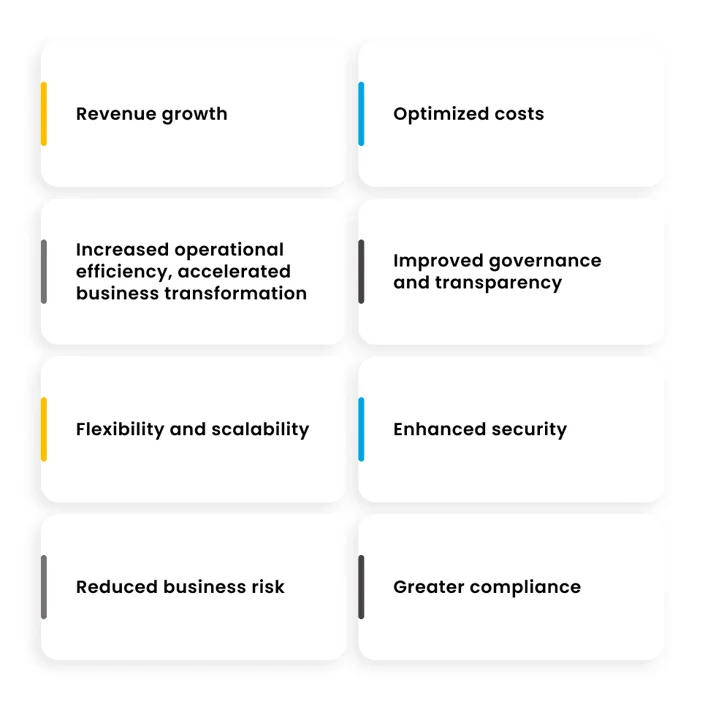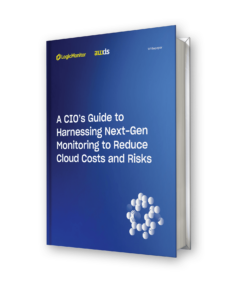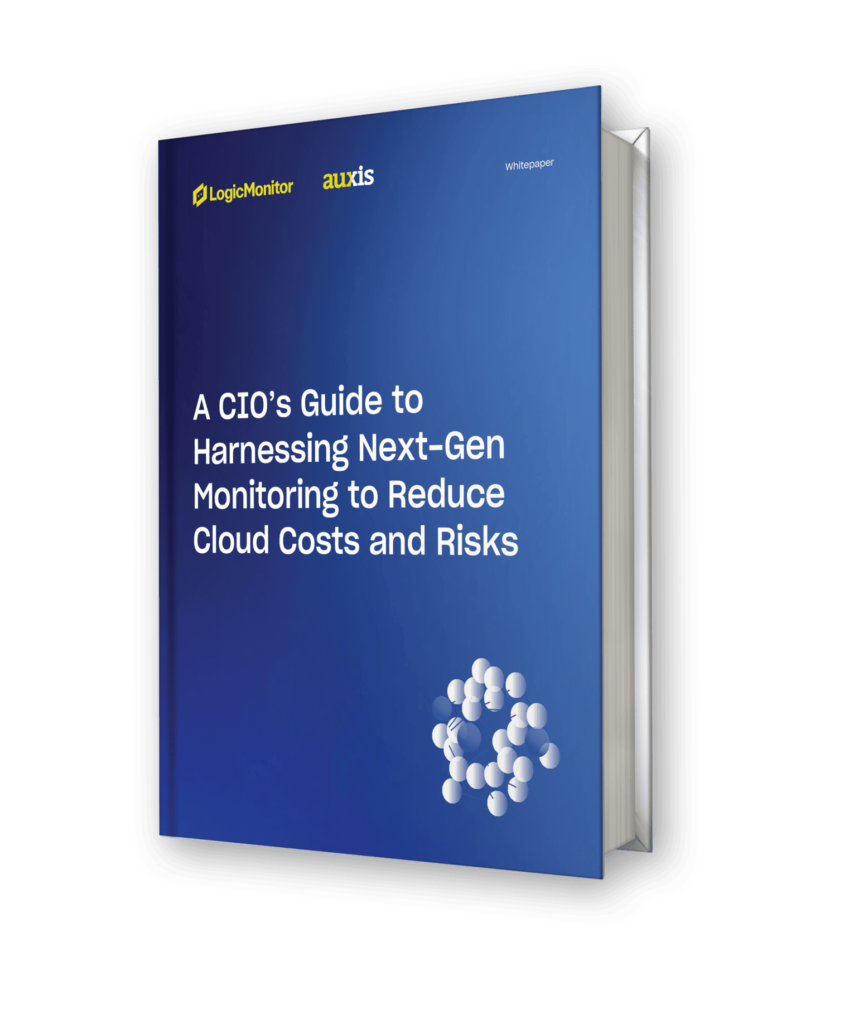“Moving to the cloud is no longer a question of if, but when and how.” “There is no business strategy without a cloud strategy leveraging the latest advancements in technologies.” These popular business adages sum up one of the most pronounced technology trends in recent years: the shift of digital technologies from on-premise to the cloud.
Organizations of all sizes are recognizing that cloud adoption is not just a means to streamline IT operations but a catalyst for innovation, scalability, and agility. The pandemic provided a major incentive for cloud adoption among enterprises, as it triggered the need to speed up the pace of enterprise digitization to keep up with increased online business and remote working.
Today, more than half of organizations are accelerating their cloud migration, and 65% are defaulting to cloud-based services for upgrades or new IT purchases, Foundry’s 2023 Cloud Computing Study found. Microsoft Azure ranks as the top overall public cloud services provider in the world with about 17% share, followed by Amazon Web Services (AWS) with a 13.5% share, according to the latest IDC Worldwide Semiannual Public Cloud Services Tracker.
The benefits of moving to the cloud are numerous, but can broadly be grouped as:

Learn more about the benefits of cloud computing for your business.
Common cloud migration missteps
Even as more organizations are transitioning greater workloads to the cloud, missteps in cloud migration are taking a toll, resulting in costly migrations and overrunning timelines and budgets. Inefficiencies in coordinating workload migration to the cloud are costing the average company 14 percent more in migration spend than planned each year, and 38 percent of companies have seen their cloud migrations delayed by more than one quarter, according to McKinsey.
Some of the most common cloud migration missteps include:
1. Migration without executive sponsorship
Without the support of the organization’s topmost executives, such as the CIO and/or CEO, crucial decisions around the migration might not align with overall business goals or stakeholder expectations, resulting in misallocated resources and mismatched priorities. C-suite support is also instrumental for bringing the entire organization on board with the migration, without which there can be ineffective communication across departments, resistance to change, lack of training, and limited adoption of the new cloud-based solutions.
2. Lack of planning
Cloud migration being a complex and expensive process, before starting, businesses need a clear understanding of the benefits to be accrued from the cloud migration process as well as the challenges they may encounter. Lack of a cohesive cloud migration strategy which accounts for both benefits and challenges can create inefficiencies and inconsistencies, and in turn, cause migration costs to soar.
3. Improper data assessment and preparation
The successful migration of data is critical to ensuring business continuity and operational efficiency. Transferring ‘dirty’ or corrupted data to the cloud can lead to inaccurate analytics, poor customer service, or compliance violations, and take a big bite out of the benefits of moving to the cloud. Data needs to be cleaned, transformed, and optimized to be successfully used in a cloud-native environment. This can be a significant cost and needs to be budgeted into the cloud migration expenses.
4. Insufficient security and poor testing
Cloud security is paramount, and the organization’s data and applications should be protected during migration by implementing appropriate security controls and monitoring your environment closely.
It is also important to test the security of all migrated systems and applications before they are put into production, including testing all security controls, as well as the overall security posture of the cloud environment. It is also important to test your backup and disaster recovery plan. This is one area where many organizations fail, and it can have disastrous consequences if something goes wrong.
5. Not optimizing cloud environment and workloads
To ensure a successful cloud migration, it is essential to optimize the cloud environment by considering performance, costs, security, and scalability. Inadequate optimization can lead to performance bottlenecks, affecting the overall user experience and hindering the scalability of applications. 38% of C-suite and IT decision-makers revealed they miscalculated the cloud budget when provisioning, which resulted in significant cloud overspending, SoftwareOne’s CIO Pulse: 2023 budgets and priorities found.
Optimizing workloads is also crucial as most existing workloads are overprovisioned, and a ‘lift and shift’ approach would send excess computing and storage capacity right along with it. Failure to optimize workloads before the rushed cloud migrations during the pandemic is now causing underperformance on digital transformation goals, 31% of those surveyed by SoftwareOne said. Prioritizing migrating workloads that would benefit the most from migration, such as those with more volatile computing needs, is also important.
6. Not choosing the right cloud provider
The careful selection of a reliable and compatible cloud provider is crucial to ensure a seamless and successful migration experience. Ill-suited cloud providers may lack the necessary infrastructure, desired scalability or integration capabilities, security measures, or technical support required to meet an organization’s migration objectives. This can result in compromised performance, increased downtime, and potential data security risks.
7. Lack of skilled staff to support migration
Lack of resources or expertise is among the top cloud challenges faced by organizations, according to Flexera’s 2023 State of the Cloud Report. Cloud migration is a complex process, and it’s important to have the right expertise on your team, including cloud architects, engineers, and security experts to leverage the proper migration tools and techniques for a successful cloud migration.

Steps for building a successful cloud migration strategy
As economic uncertainty drives cautious IT spending and forces companies to prioritize spending areas, many organizations are contending with surging cloud costs and struggling to rein in spending. More than half of all the organizations surveyed by Flexera said they spent at least $2.4 million annually on cloud computing, while about a quarter spend more than $12 million. The same report also found that for the first time in a decade, managing cloud spend has surpassed security to become the number one cloud challenge for organizations.
An effective cloud migration strategy can make migration a smooth and efficient process and help organizations realize the promised benefits and savings. Below are five steps to successfully migrate your workloads to the cloud:
1. Assess your current IT infrastructure
Before migrating to the cloud, it’s important to conduct a thorough assessment of your current IT infrastructure. This assessment should include an inventory of your servers, storage, network, and software applications. It should contain an analysis of your business processes, data flows, and usage patterns as well as an audit of your business applications: those in use, those which no longer bring value, and those which can bring more value on the cloud and can be prioritized for migration.
2. Evaluate cloud solutions and providers
Once you’ve defined your migration goals, it’s essential to evaluate different cloud solutions, including IaaS (Infrastructure as a service), PaaS (Platform as a service), and SaaS (Software as a service). These solutions have different features, costs, and scalability, and it’s important to determine which one is the most appropriate for your business.
Cloud environments often straddle different types of clouds – public, private, and hybrid – and are also often multicloud, for example, AWS, Azure, Google, etc. So, businesses also need to select the right managed services provider (MSP) they want to partner with based on the goals of the business.
Considerations to keep in mind while selecting a cloud service provider:
- Services offered: What cloud services do you need? Ensure that the provider you choose offers the services that you need, such as computing, storage, networking, and databases.
- Pricing: How much does the cloud provider charge for its services? Make sure to compare the pricing of different providers before you make a decision.
- Performance: Assess the provided to ensure they align with your requirements for scalability and performance, such as low latency and high throughput.
- Security: Learn more about the cloud platform’s security practices, including data encryption, access control, and compliance certifications, to choose a provider that offers strong security features.
- Support: Evaluate the availability and responsiveness of the provider’s support to address your technical and operational concerns effectively. Make sure to choose a provider that offers the support that you need, such as 24/7 support and technical documentation.
3. Identify and prioritize transformation opportunities
After assessing your IT infrastructure, it is important to identify and prioritize transformation opportunities in line with your strategic objectives and include them in your migration goals when appropriate. Associating your transformation initiatives with measurable business outcomes will help demonstrate value as you progress through the migration. Your migration goals should also include considerations such as cost reduction, scalability, security, and leveraging some of the latest AI and ML features. This is where gaining executive sponsorship for your migration plan is key.
4. Create a migration plan
After evaluating the cloud solutions and opportunities, it’s essential to create a detailed cloud migration plan. This plan should include timelines, costs, and a detailed roadmap for the migration. You should also identify capability gaps and cross-organizational dependencies to help you create migration strategies for improving cloud readiness, ensure stakeholder alignment, and facilitate relevant organizational change management activities.
It’s also important to consider the impact of the migration on your current IT infrastructure and to ensure that minimal disruption is caused during the migration process.
5. Test and monitor
Before migrating your production workloads, it’s essential to test and monitor the cloud solutions. This will help to ensure that the migration is successful and that the cloud solutions meet your business needs. Performing pilot migrations will help solidify your plan and timeline to ensure the migration is completed and fully tested within your change window.
Following these steps, cloud migration needs to be carried out systematically and with caution. Begin by initiating migration for non-critical workloads, allowing for thorough testing and validation of the migration plan. The performance of the migrated workloads needs to be closely monitored and any issues promptly addressed. A well-coordinated communication plan also needs to be put in place to keep stakeholders informed about the progress of the migration and any potential disruptions. Additionally, periodic assessments also need to be conducted to verify that the migration is aligned with the established goals and that the cloud solutions meet the organization’s evolving business needs, making adjustments as needed. The right adjustments can significantly decrease your cloud spend.
It’s important to have a clear governance and management plan in place for your new cloud infrastructure, including a designated team responsible for the oversight, maintenance, and security of your cloud environment. This will ensure that your cloud infrastructure is run efficiently and effectively.
Too often, businesses find they are not achieving all (or even half) the benefits promised from migrating to the cloud, simply because the process wasn’t planned, managed, executed properly or even due to third-party dependencies.
Cloud migration can be a smooth and efficient process with the right migration partner. A partner with the right combination of consulting and operational capabilities can help you create an effective cloud migration strategy and ensure proper implementation, a clear governance structure as well as post-migration support. For instance, Auxis created and implemented an effective cost management strategy for a client using Azure and AWS platforms, reducing their monthly server fees by more than 55% and Monthly Cloud Infrastructure Costs by 12%.




